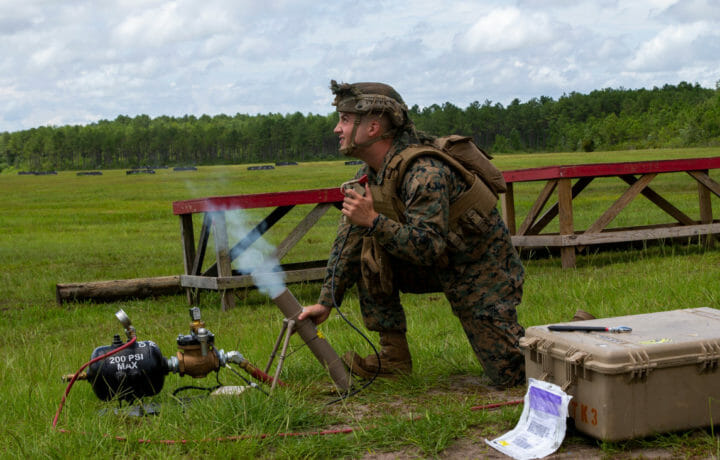The ongoing war in Ukraine – what Russia has continued to label a “special military operation” – has been noted for the number of Russian tanks that have been destroyed by man-portable anti-tank weapons including the American-made Javelin, and the British/Swedish-produced NLAW. However, as the “age of the tank” likely passes, we could be witnessing the emergence of the “age of the drone.”
The Ukrainian military has made use of a number of unmanned aerial systems (UAS) or drones, including the Turkish-made Bayraktar TB2, which can fly at 18,000 to 25,000-feet for up to 27-hours. Its range is 185-miles. The TB2 also has an auto-pilot feature and employs numerous sensors, while the drone isn’t dependent on GPS. The TB2 carries four Smart Micro Munition laser-guided missiles. It has a lower radar cross-section.
The Bayraktar has been credited with destroying numerous Russian tanks, and with striking at Russian ground positions. However, it is another drone that has been seen as a potential game changer of the war in Ukraine.
Meet the Switchblade
The aptly named Switchblade is compact in size, and unlike the larger TB2 – which carries a payload and then returns to base – this mini-drone is a “one-and-done” weapon that carries its own warhead. It acts as a “kamikaze” where it flies to a target, and then strikes according to orders.
Also called loitering munitions, these tactical drones can be carried in rucksacks and released into the air by soldiers. They’ve been successfully used to target tanks, armored vehicles, truck convoys, and artillery nests.
There are currently two models and each has a different mission. The “300” is smaller and meant for anti-personnel attacks, whereas the “600” is a bit heavier with larger warheads. It is intended to take out tanks and armored vehicles.
These drones take only minutes to launch, yet can fly at least 100-miles per hour while the 600 model still weighs just 50-pounds. It can attack targets 24-miles away and loiter for 40-minutes. The interesting thing about the Switchblade is that its attack scheme can be called off if no target presents itself. The targeting is accomplished by GPS, but it also be manually controlled.
New Weapon Developer
Development of the Switchblade began in 2011, but it has proved to be the perfect weapon for the besieged fighters in Ukraine. It was initially conceived by the U.S. Air Force Special Operations Command (AFSOC), and developed with insight from the United States Army as a platform to allow warfighters to respond to enemy ambushes in Afghanistan.
The drones are currently being produced by its developer, AeroVironment, at a secure location. The Army had awarded the company a $4.9 million contractor for the “rapid fielding” of an undisclosed number of Switchblades to forces in Afghanistan in 2011, and a year later that Army expanded that contract by another $5.1 million.
To date 700 Switchblade 300 drones have been sent to Ukraine as part of the United States arms package.
From Plowshares to Switchbades
AeroVironment, which was founded in 1971, has been best known for its lightweight human-powered and solar-powered vehicles, but in recent years began producing small drones for the U.S. military. An unarmed version of the Switchblade, dubbed the Blackwing, was first unveiled in 2015.
The company has already produced the FQM-151 Pointer for the Army and United States Marine Corps as a battlefield surveillance platform. Constructed of high-impact Kevlar, it otherwise resembled a hobbyist’s RC sailplane with a small engine. The hand-launched drone was designed to carry a CCD (charge-coupled device) camera, which did require that it be pointed directly at its target.
The RQ-14 Dragon Eye is another small reconnaissance miniature drone, developed with assistance from the Naval Research Laboratory and the Marine Corps Warfighting Laboratory, for use by the United States Marine Corps. The production contract for Dragon Eye was awarded to AeroVironment in 2003, and more than 1,000 of the small aircraft had been manufactured prior to the Marine Corps decision to switch over to another drone from AeroVironment, the RQ-11 Raven B, for the remainder of the Dragon Eye production contract.
Drone With Missile-Like Capabilities
Where the Switchblade differs from most other drones is that it doesn’t carry a payload. As noted, it functions as a “Kamikaze” or suicide weapon. Once it finds a target, its operator has the ability to order it to “dive bomb” into the target, much like a missile.
Its developers have suggested it would be highly effective against Russia’s slow moving – and often stopped – convoys. Because of its compact size, it would be difficult for the Switchblade to be seen or heard until it is too late for a stopped vehicle to react.
According to the company, there have been no known cases of a Switchblade actually being shot down. However, the radio signals can be jammed, which is about the only effective means so far of countering the small but deadly loitering munitions. As a result, the drones have been successful, yet won’t be enough to completely defeat the Russian Army.
“It’s not likely to result in a strategic shift in modern warfare, at most it’s more of a tactical shift,” explained Jeffrey Treistmman, PhD, assistant professor of national security at the University of New Haven.
“Loitering munitions are still susceptible to countermeasures and Ukrainian defenses still require conventional military hardware,” Treistmman told ClearanceJobs.
Earlier this month, Wahid Nawabi, CEO of AeroVironment, said the company is now producing thousands of the weapons and is ready to supply them to Ukraine. For Nawabi this is somewhat personal. His family fled from Afghanistan in 1982 following the Soviet invasion, and he has shared his story of seeing a Soviet helicopter gunships strike targets in his native land, and now his desire to help the Ukrainians.




